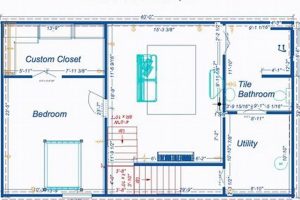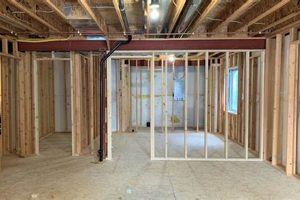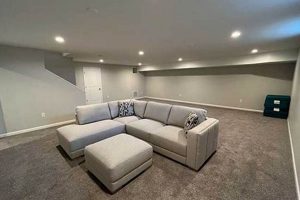A device designed to mitigate excess moisture in a below-grade, habitable area is a crucial appliance for maintaining structural integrity and occupant comfort. These devices function by extracting water vapor from the air, thereby reducing humidity levels and preventing the proliferation of mold, mildew, and other moisture-related issues often encountered in such spaces. For example, a unit placed in a recreation room can effectively manage humidity generated by everyday activities.
Maintaining optimal humidity in a finished below-ground space yields several benefits. It prevents damage to drywall, flooring, and furniture, prolonging their lifespan. Furthermore, it reduces the likelihood of respiratory problems and allergic reactions triggered by mold spores. Historically, inadequate moisture control has led to significant property damage and health concerns, highlighting the importance of effective humidity management strategies.
This article will explore key factors in selecting an appropriate unit, including capacity, features, and placement. It will also address maintenance requirements and troubleshooting common problems to ensure optimal performance and longevity.
Tips for Optimal Moisture Control in Finished Basements
Effective humidity management is crucial for maintaining the integrity and comfort of finished below-grade spaces. The following guidelines offer insights into maximizing the performance of a moisture extraction unit.
Tip 1: Select an appropriately sized unit. Capacity should be determined by the square footage of the space and the severity of the moisture problem. A unit with insufficient capacity will struggle to maintain desired humidity levels, while an oversized unit may cycle too frequently, leading to inefficient operation.
Tip 2: Strategically position the unit. Place the device in an area with high humidity or poor air circulation. Avoid positioning it near walls or furniture that may obstruct airflow. Central placement often yields the most effective results.
Tip 3: Maintain regular cleaning schedules. Clean the unit’s filter regularly, typically every one to three months, depending on usage and environmental conditions. A clogged filter reduces efficiency and can lead to overheating.
Tip 4: Monitor humidity levels. Use a hygrometer to monitor humidity levels and adjust the unit’s settings accordingly. The ideal relative humidity for a below-grade space is between 30% and 50%.
Tip 5: Ensure proper drainage. The unit should be connected to a drain or emptied regularly. Consider a model with a built-in pump for continuous drainage if a suitable drain is not readily accessible.
Tip 6: Address sources of moisture. Identify and address sources of moisture, such as leaky pipes or inadequate exterior drainage. Addressing these issues will reduce the workload on the humidity extraction unit and improve its overall effectiveness.
Tip 7: Consider energy efficiency. Look for models with Energy Star certification to minimize energy consumption and operating costs. An energy-efficient unit can save a significant amount of money over its lifespan.
Implementing these tips will contribute to a drier, healthier, and more comfortable below-grade environment. Proper moisture control prevents structural damage, inhibits mold growth, and enhances overall air quality.
The subsequent sections will delve into specific product recommendations and advanced troubleshooting techniques.
1. Capacity (Pints/Day)
The extraction rate, measured in pints per day, is a primary determinant of a humidity control device’s suitability for a finished below-grade space. Selection of a unit with appropriate extraction capability is paramount for effectively managing moisture levels and preventing related issues.
- Space Size and Volume
Larger areas necessitate higher capacity units to adequately reduce humidity. For example, a 50-pint unit may be suitable for a 1000 square foot area with moderate humidity, while a 70-pint unit may be required for the same space with higher humidity levels or if the space has higher ceilings. Inadequate capacity will result in the unit running continuously without achieving the desired humidity level.
- Severity of Moisture Problems
Areas with significant water intrusion, such as those prone to leaks or poor drainage, require higher capacity units. The unit’s extraction rate must exceed the rate of moisture introduction to maintain a comfortable and healthy environment. Ignoring this can lead to mold growth and structural damage.
- Ambient Humidity Levels
Geographic location and seasonal variations impact ambient humidity. Regions with consistently high humidity necessitate units with greater capacity. In such environments, a lower-capacity unit may prove ineffective during peak humidity seasons, resulting in persistently damp conditions.
- Occupancy and Activity Levels
Activities such as showering, cooking, and laundry can increase humidity levels within a below-grade space. Higher occupancy also contributes to increased humidity. Consequently, spaces with frequent activity or multiple occupants require higher capacity units to offset the increased moisture load.
Ultimately, selecting a unit with appropriate “Capacity (Pints/Day)” is critical for ensuring effective moisture control in finished below-grade environments. Failure to consider these factors can lead to inadequate humidity management, resulting in structural damage, mold growth, and compromised indoor air quality. Careful assessment of space size, moisture sources, ambient humidity, and activity levels is essential for determining the optimal extraction capacity.
2. Drainage Options
Efficient removal of collected condensate is paramount for the sustained operation of a humidity control device in finished below-grade spaces. The available drainage mechanisms significantly influence user convenience and the prevention of water damage.
- Manual Emptying
This option involves the periodic removal of a collection tank. It is suitable for intermittent use or when a drainage point is inaccessible. However, manual emptying necessitates regular monitoring to prevent overflow, which can damage flooring and promote mold growth. The frequency of emptying depends on the extraction rate and ambient humidity.
- Gravity Drain
A gravity drain utilizes a hose connected to a floor drain or sump pump. This provides continuous drainage, eliminating the need for manual intervention. Proper hose placement is critical to ensure unobstructed flow. The drain location must be lower than the unit’s outlet to facilitate gravity’s function, mitigating potential backflow and spillage.
- Condensate Pump
A condensate pump allows for upward drainage, enabling the unit to discharge water to a sink or higher-level drain. This is particularly beneficial when a gravity drain is unavailable or impractical. Condensate pumps require electricity and occasional maintenance to ensure reliable operation. Pump failure can lead to water accumulation and potential flooding.
- Hose Connection Compatibility
The compatibility and robustness of the hose connection are crucial for preventing leaks and ensuring reliable drainage. A secure connection minimizes the risk of water damage. Regularly inspect the hose and connection for wear, cracks, or blockages to maintain proper function.
The selection of appropriate “Drainage Options” directly impacts the convenience and effectiveness of a moisture control strategy in finished below-grade environments. Careful consideration of these factors is vital for preventing water damage, minimizing maintenance, and ensuring long-term performance of the humidity control device. The choice depends on factors such as drain accessibility, frequency of use, and risk tolerance for manual intervention.
3. Energy Efficiency
Operating a humidity control appliance in a finished below-grade space necessitates careful consideration of energy consumption. The extended operational periods often required to maintain optimal humidity levels can lead to significant energy expenditures. Therefore, selecting a unit with high energy efficiency is critical for minimizing operating costs and reducing environmental impact. An inefficient unit may negate the benefits of a comfortable living space through excessive energy bills and increased carbon footprint.
Several factors contribute to the energy efficiency of these appliances. These include the compressor type, refrigerant used, and overall design. Models bearing the Energy Star certification meet stringent efficiency standards and typically consume significantly less energy than non-certified models. For example, an Energy Star certified unit might use 15% less energy than a standard model with comparable extraction capacity. This difference translates to substantial savings over the lifespan of the appliance. Furthermore, features such as automatic shut-off when the desired humidity level is reached, and programmable timers can further reduce energy consumption.
Ultimately, the economic and environmental advantages of prioritizing “Energy Efficiency” in a “dehumidifier for finished basement” are considerable. While the initial purchase price of an energy-efficient unit may be higher, the long-term cost savings and reduced environmental impact make it a worthwhile investment. Prudent selection, coupled with appropriate usage and maintenance, ensures that the benefits of a comfortable and dry below-grade space are not offset by excessive energy consumption. The key takeaway is to carefully evaluate energy efficiency ratings and features before purchase to optimize both performance and cost-effectiveness.
4. Placement Strategy
Optimal positioning of a humidity control device within a finished below-grade space is critical for maximizing its efficiency and effectiveness. An ill-placed unit may fail to adequately address moisture issues, leading to wasted energy and potential damage to the structure and its contents.
- Airflow Optimization
Positioning the unit in an area with unobstructed airflow is essential. Restricting airflow reduces the unit’s ability to draw in and process humid air. Avoid placing the device behind furniture, in corners with limited circulation, or near walls that might impede airflow. Central placement, whenever feasible, promotes more uniform humidity reduction throughout the space.
- Proximity to Moisture Sources
Strategic placement near common moisture sources can enhance the unit’s ability to proactively manage humidity. For instance, positioning the device near a laundry area, bathroom, or area prone to leaks allows it to address elevated humidity levels directly at the source. However, direct contact with water should be avoided to prevent electrical hazards.
- Distance from Walls and Obstructions
Maintaining adequate clearance between the unit and surrounding walls or obstructions is necessary for proper ventilation and airflow. Manufacturers typically recommend a minimum clearance distance, which should be adhered to for optimal performance. Insufficient clearance can lead to overheating and reduced efficiency.
- Accessibility for Maintenance
The chosen location should allow for easy access to the unit for routine maintenance tasks, such as filter cleaning and water reservoir emptying (if applicable). Difficult-to-reach locations may discourage regular maintenance, leading to reduced efficiency and potential equipment failure. A readily accessible location ensures consistent and timely maintenance, maximizing the unit’s lifespan and performance.
Effective “Placement Strategy” is a non-negotiable aspect of utilizing a “dehumidifier for finished basement”. By considering airflow, proximity to moisture sources, clearance, and accessibility, users can significantly improve the performance and longevity of their humidity control equipment, ensuring a drier, healthier, and more comfortable below-grade environment. Failure to consider these factors can result in suboptimal performance and potentially negate the benefits of the appliance altogether.
5. Maintenance Schedule
Adherence to a consistent maintenance schedule is paramount for ensuring the sustained functionality and optimal performance of a humidity control device deployed in a finished below-grade space. Neglecting routine maintenance can diminish the unit’s effectiveness, shorten its lifespan, and potentially lead to costly repairs.
- Filter Cleaning or Replacement
The filter prevents dust and debris from entering the unit, ensuring efficient airflow. A clogged filter reduces airflow, increases energy consumption, and can lead to overheating. Filters should be cleaned monthly or replaced quarterly, depending on the environment. For example, in areas with high dust levels, more frequent cleaning is necessary. Neglecting filter maintenance directly impacts the unit’s ability to effectively remove moisture and can cause premature component failure.
- Coil Cleaning
The coils are responsible for cooling the air and condensing moisture. Over time, dust and debris can accumulate on the coils, reducing their efficiency. Coils should be cleaned annually using a soft brush or vacuum attachment. In environments with high humidity or dust, more frequent cleaning may be required. Inefficient coils compromise the unit’s cooling capacity, leading to reduced moisture extraction and increased energy consumption. A unit operating with dirty coils must work harder and longer to meet desired conditions, shortening component life.
- Drainage System Inspection
The drainage system, including the collection tank, drain hose, and condensate pump (if equipped), must be regularly inspected for clogs or blockages. Blocked drainage can cause water to back up, leading to leaks and potential water damage. The tank should be emptied regularly, and the drain hose should be checked for kinks or obstructions. Condensate pumps should be inspected annually for proper operation. Failure to maintain the drainage system can result in water damage to the surrounding area and compromise the unit’s functionality. A flooded unit will cease to operate, requiring extensive repairs or replacement.
- Component Inspection
A periodic inspection of the unit’s components, including the compressor, fan motor, and electrical connections, is essential for identifying potential issues before they escalate. Listen for unusual noises, check for signs of overheating, and inspect electrical connections for corrosion or damage. Any identified problems should be addressed promptly by a qualified technician. Neglecting component inspection can result in catastrophic failure, leading to costly repairs or replacement. A proactive approach to component inspection minimizes downtime and extends the unit’s operational life.
Consistent adherence to a comprehensive “Maintenance Schedule” is indispensable for maximizing the performance and longevity of a “dehumidifier for finished basement”. Regular filter cleaning, coil maintenance, drainage system inspection, and component assessment collectively contribute to a well-functioning unit that effectively mitigates moisture-related issues, protects property, and promotes a healthy below-grade environment. Conversely, neglecting maintenance can lead to diminished performance, increased energy consumption, and ultimately, premature equipment failure, underscoring the importance of proactive maintenance practices.
Frequently Asked Questions
This section addresses common inquiries regarding the selection, operation, and maintenance of devices designed to mitigate excess moisture in below-grade finished spaces. The information presented aims to provide clarity and guidance for optimal performance and longevity of these appliances.
Question 1: What capacity of humidity extraction unit is appropriate for a 500 square foot finished below-grade area?
The appropriate capacity depends on several factors, including the severity of moisture intrusion, the presence of vapor barriers, and the number of occupants. As a general guideline, a 30-pint unit may be sufficient for mildly damp conditions, while a 50-pint unit is recommended for more significant moisture challenges. Consultation with a qualified HVAC professional is advisable for accurate assessment.
Question 2: Is continuous drainage always preferable to manual emptying?
Continuous drainage offers the convenience of eliminating the need for manual emptying, but it requires a suitable drainage point, such as a floor drain or sump pump. Manual emptying may be more practical in situations where a drainage point is not readily accessible or when the unit is used only intermittently. The choice depends on individual circumstances and preferences.
Question 3: How frequently should the filter be cleaned or replaced on a humidity extraction unit?
Filter cleaning or replacement frequency depends on environmental conditions and usage patterns. In general, filters should be cleaned monthly or replaced quarterly. However, in areas with high dust or pollen levels, more frequent cleaning or replacement may be necessary to maintain optimal performance and prevent reduced airflow.
Question 4: Can a standard household humidity control device be used effectively in a finished below-grade space?
While standard household units may provide some degree of moisture control, they are often not designed to handle the typically higher humidity levels and lower temperatures found in below-grade environments. Units specifically designed for use in below-grade spaces typically offer greater capacity, more robust construction, and features tailored to these unique conditions.
Question 5: Does the Energy Star certification guarantee optimal performance?
The Energy Star certification indicates that a unit meets certain minimum energy efficiency standards. However, it does not guarantee optimal performance in all situations. The unit’s performance will still depend on factors such as proper sizing, placement, maintenance, and environmental conditions. Energy Star certification is a valuable indicator of efficiency but should not be the sole criterion for selection.
Question 6: What are the potential consequences of neglecting to address moisture issues in a finished below-grade area?
Neglecting to address moisture issues can lead to a range of problems, including mold growth, structural damage, compromised indoor air quality, and increased energy costs. Mold growth can trigger allergic reactions and respiratory problems, while structural damage can lead to costly repairs. Proactive moisture management is essential for protecting property and maintaining a healthy living environment.
Proper application of the provided guidance ensures a comfortable and healthy environment. Regular maintenance and proactive moisture management are the cornerstones of long-term success.
The subsequent section will explore advanced troubleshooting techniques for common problems encountered with these appliances.
Conclusion
The preceding discussion has underscored the importance of selecting, deploying, and maintaining a “dehumidifier for finished basement”. Key considerations include appropriate capacity, drainage options, energy efficiency, placement strategy, and a rigorous maintenance schedule. Effective management of these factors directly impacts the longevity of the appliance and the preservation of the below-grade environment.
Given the potential for structural damage, health risks, and diminished property value associated with uncontrolled humidity, investment in a suitable “dehumidifier for finished basement” and diligent adherence to recommended maintenance practices are not merely advisable but essential. Continued vigilance and proactive intervention are crucial for safeguarding the integrity and habitability of finished below-grade spaces.







